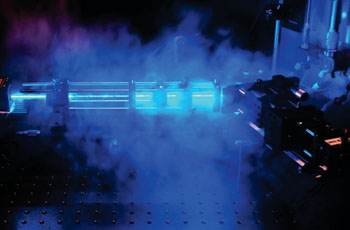Automatic Cytometer Tallies Tumor Cells in Blood
By LabMedica International staff writers
Posted on 20 May 2015
Flow cytometry has been used to count cancer cells for many years, but the large instruments are expensive and can only be operated by trained personnel.Posted on 20 May 2015
Existing flow cytometers are capable of measuring the quantity of tumor cells circulating in the bloodstream but they often cost up to EUR 300,000 and can take up a huge amount of space, equivalent to two washing machines.

Image: The measuring channel that forms the key component of the PoCyton cytometer is visible on the right-hand side of the image (Photo courtesy of Fraunhofer ICT-IMM).
Scientists at the Fraunhofer Institute for Chemical Technology (Munich, Germany) have developed the PoCyton cytometer which is cheap to produce, no bigger than a shoebox, and automated. All the PoCyton flow cytometer needs is a sample of the patient's blood, and within a short time the attending physician will know how many tumor cells are circulating in the blood. Cancerous growths release cells into the bloodstream, and their number provides an indication of how effective the therapy has been. If the number of cancerous cells decreases in the course of treatment, it shows that it has been effective.
Flow cytometry works on the following principle: A fluorescent dye is injected into the blood, and the dye molecules bind to the tumor cells, leaving all other cells unmarked. Whereas until now the physician had to add the dye to the blood sample manually, this now takes place automatically in the PoCyton process. The blood is funneled through a narrow focal area, causing all suspended cells to pass one by one in front of a laser spot detector. The light causes the cells to which the dye has attached itself, the tumor cells, to fluoresce, enabling the device to detect and count them. This narrow passage is the key to the PoCyton process.
Michael Bassler, PhD, a senior scientist who helped develop the cytometer, said, “We designed it in such a way that the throughput is 20 times greater than in conventional cytometry. At the same time, its geometry was chosen to ensure that no cells pass in front of one another. In this way the scientists can be sure that the system registers every single object flowing past the detector, and that no cell is hidden behind another. Such errors could have dramatic consequences, because a mere 10 mL sample of blood contains around one billion suspended objects. Of these, only five are circulating tumor cells, even in a severely sick patient.”
Related Links:
Fraunhofer Institute for Chemical Technology














